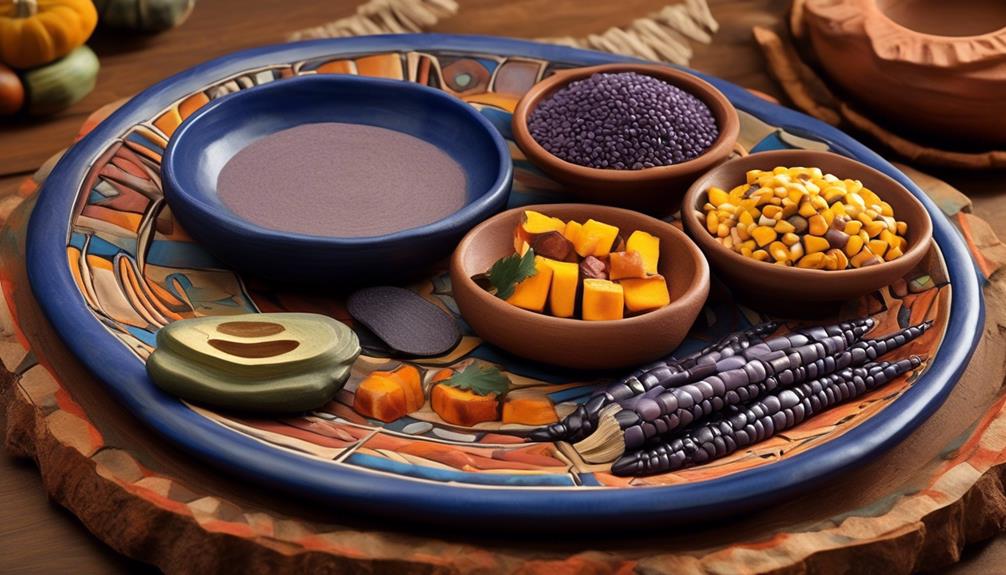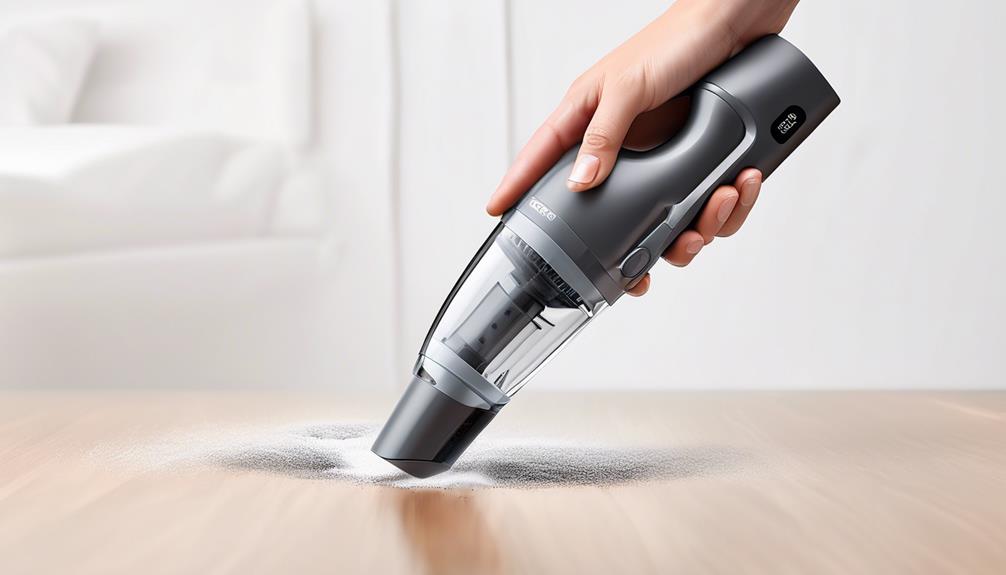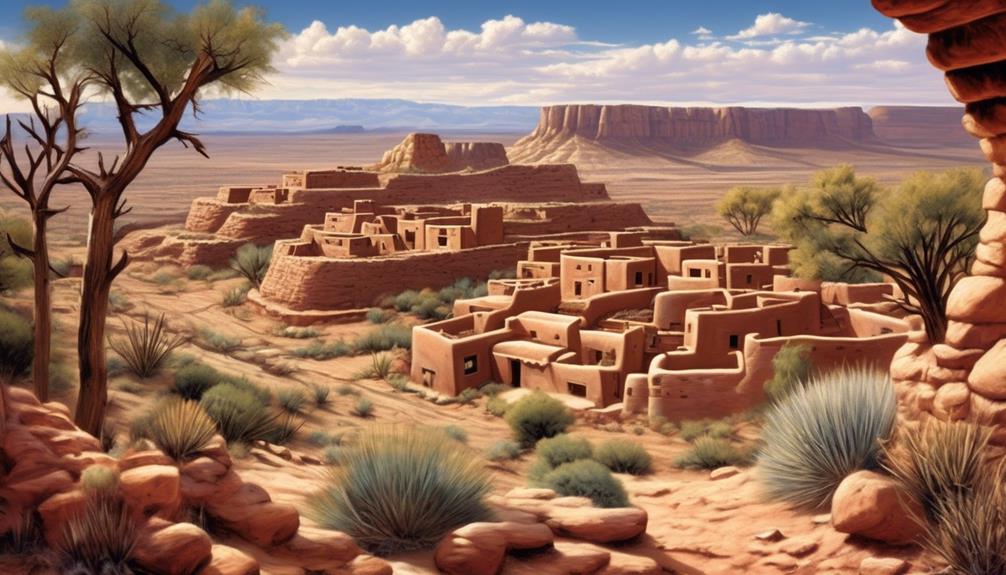Have you ever wondered what other foods were part of the diet of the Hopi Indian tribe, known for cultivating the famous blue corn?
The Hopi people had a rich and diverse culinary tradition that encompassed not only their staple agricultural products, but also wild plants foraged from the desert and game hunted in the surrounding areas.
Their traditional cooking methods and the cultural and spiritual significance of certain foods offer a fascinating insight into their way of life.
So, what exactly did the Hopi tribe eat beyond their renowned blue corn?
Key Takeaways
- Corn, beans, and squash, known as the 'Three Sisters', are the primary agricultural staples of the Hopi Indian tribe, deeply rooted in their cultural traditions.
- The Hopi people practice sustainable agriculture techniques, including crop rotation, to maintain soil fertility and prevent nutrient depletion, enabling consistent harvests of their staple crops.
- Wild plant foraging, including plants like tepary beans, prickly pear cactus, amaranth, and purslane, is an important part of the Hopi tribe's traditional diet and cultural practices, and sustainable foraging practices have ensured the availability of these plants for generations.
- Game hunting is significant in the cultural and dietary practices of the Hopi tribe, with sustainable hunting practices and conservation efforts deeply embedded in their traditions. However, climate change has impacted the availability of game animals, requiring adaptations in hunting practices.
Agricultural Staples
The agricultural staples of the Hopi Indian tribe primarily consist of corn, beans, and squash, known as the 'Three Sisters.' These crops aren't only significant in their diet but also deeply rooted in their cultural traditions.
The Hopi people have developed sophisticated agricultural practices to ensure the fertility of their soil and the sustainability of their crops. One such practice is the implementation of crop rotation, where different crops are planted in a cyclical manner to maintain soil fertility and prevent depletion of nutrients. This method allows the soil to naturally restore its nutrients while reducing the risk of pests and diseases that can affect specific crops.
The Hopi people's deep understanding of the land and its resources has enabled them to cultivate these staple crops successfully for generations. By practicing sustainable agriculture techniques such as crop rotation, the Hopi tribe has been able to maintain the fertility of their soil and ensure a consistent harvest of their agricultural staples.
Wild Plant Foraging

Wild plant foraging plays a significant role in the traditional diet and cultural practices of the Hopi Indian tribe. The Hopi people have a deep knowledge of the land and have traditionally relied on wild plant identification and sustainable foraging practices to supplement their diet. This practice not only provided essential nutrients but also reinforced their connection to the land and its natural resources.
—
| Wild Plant | Uses | Season |
|---|---|---|
| Tepary Beans | Food, ceremonial use | Summer |
| Prickly Pear Cactus | Food, medicine | Late summer |
| Amaranth | Food, dye, medicine | Late summer |
| Purslane | Food, medicinal herb | Summer |
—
The table illustrates some of the wild plants foraged by the Hopi tribe, showcasing the diverse uses and the season in which they are typically harvested. Tepary beans are a vital food source and are also used in ceremonial practices. The prickly pear cactus and amaranth serve as both food and medicinal resources. Purslane is valued for its nutritional benefits and medicinal properties. The Hopi's sustainable foraging practices have ensured the continued availability of these wild plants for generations.
Game Hunting
Having explored the traditional practice of wild plant foraging among the Hopi Indian tribe, we now turn our attention to their methods and significance of game hunting in their cultural and dietary practices.
Sustainable hunting practices were crucial to the Hopi tribe, as they relied on the game for not only sustenance but also for ceremonial and spiritual purposes. Ethical considerations were deeply embedded in their hunting practices, with a strong emphasis on respecting the animals and the natural world. The Hopi people viewed themselves as stewards of the land, and this perspective greatly influenced their hunting traditions.
The impact of climate change on game availability was a growing concern for the Hopi tribe. Changes in weather patterns and habitat loss directly affected the abundance and distribution of game animals. As a result, the Hopi people had to adapt their hunting practices and rituals to accommodate these changes. Additionally, they sought to raise awareness and promote conservation efforts to mitigate the effects of climate change on the availability of game for future generations.
The interplay between sustainable hunting, ethical considerations, and environmental challenges underscores the intricate relationship that the Hopi tribe had with game hunting as an integral part of their cultural and dietary heritage.
Traditional Cooking Methods

An essential aspect of Hopi Indian traditional cooking involves utilizing age-old techniques to prepare meals that reflect their deep connection to the land and cultural heritage. The Hopi people have developed unique cooking methods and preservation techniques that have been passed down through generations. Seasonal ingredients play a crucial role in their food preparation, influencing the cooking techniques and preservation methods employed.
| Cooking Techniques | Preservation Methods | Seasonal Ingredients |
|---|---|---|
| 1. Piki Bread | 1. Sun-Drying | 1. Blue Corn |
| Thin, delicate bread made by spreading batter on a hot stone. | After making the bread, it is sun-dried and carefully stored. | Blue corn, which is abundant in the region, is used to make this traditional bread. |
| 2. Roasting | 2. Smoking | 2. Squash, Beans |
| Meats and vegetables are roasted over an open flame or in clay ovens. | Smoking meats is a common preservation method. | Squash and beans are staple ingredients, often incorporated into various dishes. |
| 3. Boiling | 3. Pickling | 3. Wild Herbs |
| Boiling is used to cook stews and soups. | Pickling is used to preserve excess vegetables. | Wild herbs are foraged and used to season and flavor many dishes. |
These cooking techniques and preservation methods showcase the Hopi people's resourcefulness in using what the land provides and their deep understanding of seasonal ingredients.
Cultural and Spiritual Significance
The cultural and spiritual significance of traditional Hopi Indian cuisine is deeply rooted in their connection to the land and their ancestral traditions.
- Ritual Feasting
- The Hopi tribe considers certain traditional dishes as essential elements in various ceremonial and ritual feasts, such as the Niman Kachina ceremony, where specific foods play a crucial role in honoring the spirits and ancestors.
- Food is also central to the Hopi Snake Dance, a prayer for rain and fertility. Corn, a staple food, is used in various forms during these rituals, symbolizing the sustenance provided by the land and expressing gratitude.
- Food Taboos
- The Hopi people adhere to strict food taboos, governed by religious and spiritual beliefs. For instance, certain foods are prohibited during specific ceremonies or seasons.
- There are also communal food restrictions, where certain foods are only consumed by specific groups or individuals, emphasizing the importance of communal harmony and respect for tradition.
- Connection to Ancestral Traditions
- Hopi cuisine embodies the wisdom passed down through generations, preserving the cultural and spiritual heritage of the tribe.
- The preparation and consumption of traditional Hopi foods are intertwined with spiritual teachings, reinforcing the sacred bond between the Hopi people and the land.
Frequently Asked Questions
How Did the Hopi Indian Tribe Store and Preserve Their Food?
We store and preserve our food using various techniques. The Hopi Indian tribe utilized food preservation methods such as drying, smoking, and fermentation. These techniques allowed us to store food for extended periods, ensuring availability during lean times.
Additionally, we stored food in underground pits and ceramic pots to protect it from spoilage. Our traditional cooking methods involved using seasonal ingredients and cooking over open fires or in earthen ovens.
Did the Hopi Tribe Have Any Specific Rituals or Ceremonies Related to Food?
In the Hopi culture, ritual practices and food offerings hold significant importance. These customs are deeply ingrained in our daily lives and are an integral part of our spiritual beliefs.
The act of preparing and presenting food for ceremonies is a sacred tradition that connects us to our ancestors and the natural world. It's a way of honoring and showing gratitude for the blessings we receive.
What Were the Gender Roles in Food Preparation and Gathering Within the Hopi Tribe?
In Hopi culture, gender roles in food preparation and gathering were well-defined. While men were responsible for hunting and farming, women held the primary role in food preparation and gathering. They'd use traditional recipes and preservation techniques to ensure food sustainability.
The division of labor was essential for maintaining the tribe's food supply and ensuring each member's well-being. These gender roles in food-related activities were deeply rooted in the tribe's cultural traditions.
How Did the Introduction of European Settlers and Their Foods Impact the Traditional Diet of the Hopi Tribe?
The impact of colonization on the traditional diet of the Hopi tribe resulted in significant dietary changes.
With the introduction of European settlers and their foods, the Hopi people experienced a shift in their food consumption patterns.
This led to a transformation in their culinary practices and nutritional habits.
The influence of outside food sources altered the traditional foodways of the tribe, reflecting the broader impact of colonization on indigenous diets and cultural practices.
Are There Any Traditional Recipes or Dishes That Are Still Commonly Prepared and Enjoyed by the Hopi Tribe Today?
Traditional recipes and culinary traditions are still cherished by the Hopi tribe today. Native ingredients like corn, beans, and squash form the basis of many dishes. Hopi cuisine reflects a deep connection to the land and is celebrated through staples like piki bread, hominy stew, and blue corn mush. These dishes continue to be prepared and enjoyed, preserving the tribe's rich culinary heritage.
One adage comes to mind: 'Food is our common ground, a universal experience.'
Conclusion
In conclusion, the Hopi Indian tribe's diet consisted of agricultural staples, wild plant foraging, and game hunting.
Their traditional cooking methods and the cultural and spiritual significance of their food reflect their deep connection to the land and their ancestors.
The Hopi's diet is a testament to their resilience and resourcefulness, evoking a sense of admiration for their ability to sustain themselves in harmony with nature.









